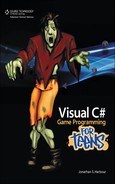Book Description
VISUAL C# GAME PROGRAMMING FOR TEENS teaches teens and other beginners how to create games using C# and Windows Forms (GDI+). A true beginner's guide, this book covers each essential step for creating your own complete role-playing game, including a character creation screen and a combat system. This book serves as a comprehensive introductory guide for readers who are new to programming or new to programming for games. The reader is shown how to load and draw bitmaps, create sprites, render a game world, keep track of inventory and character stats, and build tools: a level editor, character editor, item editor, monster editor. Every chapter contributes toward a growing game library that is used to improve and add new and more advanced features to the game, and when the student is finished they will have created a complete game.
Table of Contents
- Copyright
- Acknowledgments
- About the Author
- Introduction
- I. Dungeon Prerequisites
- 1. Welcome to the Dungeon
- 2. Drawing Shapes and Bitmaps with GDI+
- 3. Sprites and Real-Time Animation
- 4. Collision Detection
- 5. Playing Sound Effects and Music
- II. Building the Dungeon
- III. Exploring The Dungeon
- 10. Creating Characters and Monsters
- 11. Dialogue: Trainers, Vendors, and NPCs
- 12. Fighting Monsters, Gaining Experience, and Leveling Up
- 13. Equipping Gear and Looting Treasure
- 14. Populating the Dungeon
- 15. Deep Places of the World
